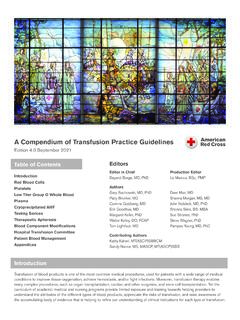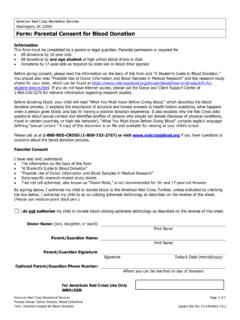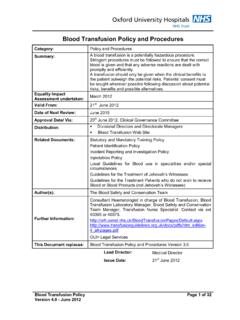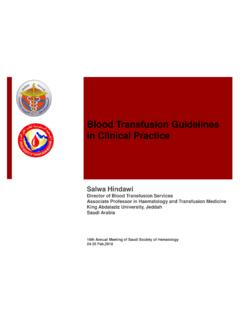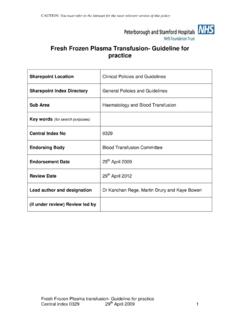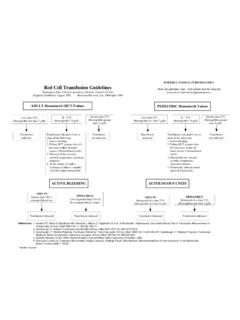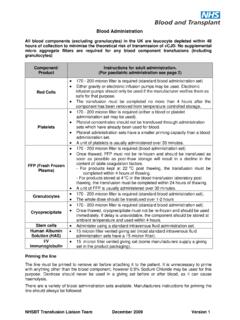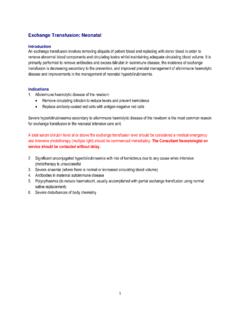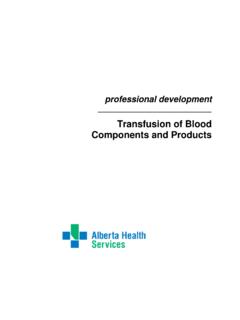Transcription of A Compendium of Transfusion Practice Guidelines
1 Table of ContentsIntroductionRed Blood CellsPlateletsLow Titer Group O Whole BloodPlasmaCryoprecipitated AHFT esting SericesTherapeutic ApheresisBlood Component ModificationsHospital Transfusion CommitteePatient Blood ManagementAppendicesIntroductionTransfus ion of blood products is one of the most common medical procedures, used for patients with a wide range of medical conditions to improve tissue oxygenation, achieve hemostasis, and/or fight infections. Moreover, Transfusion therapy enables many complex procedures, such as organ transplantation, cardiac and other surgeries, and stem cell transplantation. Yet the curriculum of academic medical and nursing programs provide limited exposure and training towards helping providers to understand the attributes of the different types of blood products, appreciate the risks of Transfusion , and raise awareness of the accumulating body of evidence that is helping to refine our understanding of clinical indications for each type of Transfusion .
2 A Compendium of Transfusion Practice GuidelinesEdition January 2021 While the approach to Transfusion medicine has historically been based on personal experience, local Practice , expert opinion, and consensus conference recommendations, the availability of hemovigilance data that document the adverse effects of Transfusion , randomized controlled trials (RCTs) demonstrating both the benefits and risks of Transfusion , and growing debates regarding alternate therapies provide a good foundation to develop evidence-based resources to aid in Transfusion care of today and the is a growing belief that Transfusion therapy, like many other types of drug therapies, can be tailored or personalized to address specific patient and disease contexts.
3 One example is in the care of the actively hemorrhaging patient, particularly in the prehospital time frame. Though not yet supported by RCTs, there is a small but growing Practice of utilizing cold-stored low titer group O whole blood containing functional platelets in lieu of balanced component therapy. The utility of other new products, such as cold-stored platelets, are also being actively debated in the actively bleeding population. In fact, clinical trials will soon be initiated to assess the feasibility and efficacy of low titer O whole blood and cold stored platelets in prehospital trauma and post complex cardiac surgery patients, respectively. In parallel, there are recent data to support reevaluating Transfusion triggers for neonatal platelet transfusions and red cell Transfusion triggers in outpatient settings for patients with chronic symptomatic anemia due to marrow failure.
4 These examples highlight a shift in Transfusion Practice towards one in which specific use case scenarios (context of active bleeding, age, and/or inpatient vs. outpatient) define Transfusion triggers or choice of blood product to ensure that Transfusion therapy is optimized. Transfusion safety continues to be the highest priority for our society and efforts to identify methods to reduce the risk of both known and emerging pathogens in all blood products are being investigated in current clinical trials. Pathogen reduction technology can successfully address infection risk from viral and bacterial pathogens. FDA approval of one such system, the INTERCEPT System, for platelets and plasma has led to both increased availability and adoption of pathogen reduced (PR) platelets by blood centers and hospitals.
5 Growth in the manufacturing of PR platelets has resulted in a concomitant increase in the use of platelet additive solutions such as PAS-C. The concepts of patient-centered blood management (PBM) continue to be a major force in the health care community, with the focus of ensuring the right product for the right patient at the right dose and time. Optimum patient care and PBM principles require that the medical staff agree to a set of Practice Guidelines for ordering and administering blood products. Practice Guidelines now can be grounded in well-designed clinical trials that clearly establish the safety, and in some cases superiority, of restrictive red cell Transfusion practices . This is supported by the results of the latest National Blood Collection and Utilization Surveys documented a continued decline of greater than 13% in both RBC and platelet transfusions between 2013 to 2015 but remained relatively unchanged between 2015 and 2017.
6 However, variability in patient and laboratory parameters defining Transfusion triggers between and within hospitals is still common, often reflecting hospital tradition as well as local and community Practice . Moreover, despite the continued decline in overall RBC use, the use of group O negative RBCs continues to climb, putting pressure on a limited supply. In some hospitals, the use rate of O negative RBCs can be as high as 17-20%, suggesting a significant opportunity to standardize Transfusion practices . National and local Practice Guidelines around appropriate Transfusion triggers and use of universal blood products, such as group O negative RBCs, are powerful tools to minimize this variation and optimize clinical importance of optimum Transfusion Practice is now under the purview of accrediting and regulatory agencies, such as The Joint Commission and AABB.
7 Blood Transfusion is acknowledged to be a therapy that involves risks, so that each organization s performance monitoring and improvement program must address the use of blood and blood components, requiring that hospitals institute a cross-functional group of medical and support staff charged with the responsibility of oversight. Regulatory agencies are also turning their attention to sustainability of the blood supply, specifically This Compendium is a review of the current blood usage Guidelines published in English in peer-reviewed journals. Whenever possible, RCTs are included, but where lacking, the discussion is informed by expert panels and retrospective cohort studies. We have, when possible, avoided single institution studies and controversial retrospective studies whose analysis and conclusions appear to be confounded, until prospective RCT data are available (for example, fresh versus old blood).
8 This edition also highlights and expands on the emerging new products, such as low titer whole blood. Other changes include discussion on laboratory diagnostic testing support for transfusions and an overview of therapeutic apheresis services. The authors, all of whom are physicians or laboratory staff for the American Red Cross, have made every attempt to fairly reproduce the advice and lessons contained in these publications. Our hope is that this document will be a valuable resource to hospital staff who obtain blood components, diagnostic testing and therapeutic apheresis services from the American Red Cross as they develop and update their blood usage Guidelines to help improve patient care. Red Blood CellsRed Blood CellsComponentsApproved name: Red blood cellsCommonly used names: Packed cells Red cells Packed red blood cells RBCs Description (1-3)Red Blood Cells (RBCs) consist of erythrocytes concentrated from a whole blood donation or collected by apheresis.
9 They contain citrate anticoagulant and usually one of several types of preservative solutions. Depending on the preservative-anticoagulant system, the hematocrit (Hct) of RBCs is about 55-65% for additive solutions (AS), AS-1, AS-3, AS-5, AS-7 and about 65-80% for citrate-phosphate-dextrose-adenine solutions, CPDA-1, CPD, CP2D. RBCs contain 20-100 mL of donor plasma, but usually <50 mL, in addition to preservative and anticoagulant. The typical volume of AS RBCs including additive solution is 300-400 mL. Each unit contains approximately 50-80 g of hemoglobin (Hgb) or 160-275 mL of red cells, depending on the Hgb level of the donor, the starting whole blood collection volume, and the collection and processing methods. Leukocyte-reduced RBCs must retain at least 85% of the original RBCs.
10 Each unit of RBCs contains approximately 250 mg of iron, almost entirely in the form of Hgb. This varies, of course, depending on the original volume and concentration of the unit. Selection and PreparationUnless there is an urgent need for blood, RBCs should be compatible whenever possible with antibodies present in the recipient s plasma (on some occasions when a patient is multiply alloimmunized, a hospital might elect to transfuse over one of the antibodies if completely antigen-negative blood cannot be found). They must be crossmatched serologically or electronically, as applicable, to confirm this compatibility. Antibodies include naturally occurring isoantibodies anti-A and/or anti-B, (depending on the donor s blood type) and alloantibodies formed in response to red cell antigen exposure from pregnancy, a prior Transfusion , or from the sharing of needles for injecting drugs.
